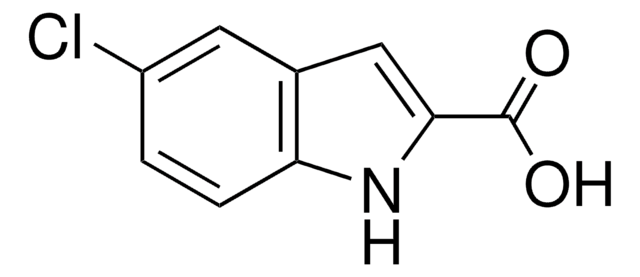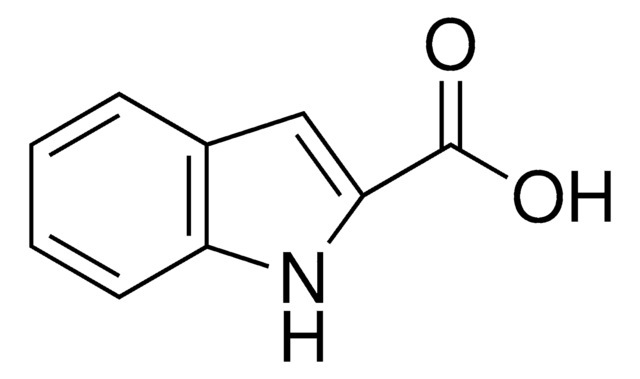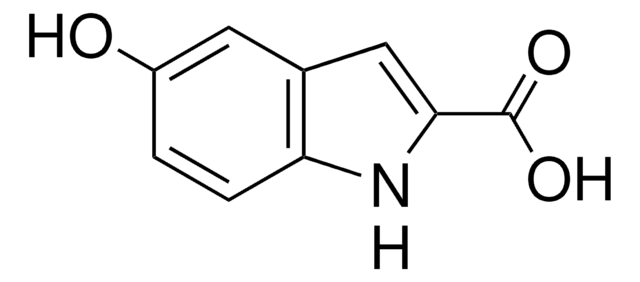265128
5-Fluoroindole-2-carboxylic acid
99%
Iniciar sesiónpara Ver la Fijación de precios por contrato y de la organización
About This Item
Fórmula empírica (notación de Hill):
C9H6FNO2
Número de CAS:
Peso molecular:
179.15
EC Number:
MDL number:
UNSPSC Code:
12352100
PubChem Substance ID:
NACRES:
NA.22
Productos recomendados
Quality Level
assay
99%
form
solid
mp
259 °C (dec.) (lit.)
functional group
carboxylic acid
fluoro
SMILES string
OC(=O)c1cc2cc(F)ccc2[nH]1
InChI
1S/C9H6FNO2/c10-6-1-2-7-5(3-6)4-8(11-7)9(12)13/h1-4,11H,(H,12,13)
InChI key
WTXBRZCVLDTWLP-UHFFFAOYSA-N
General description
5-Fluoroindole-2-carboxylic acid is an antagonist of the glycine site within the NMDA (N-methyl-D-aspartate) receptor complex.
Application
Reactant for the synthesis of:
- Fungicidal agents
- Antitumor agents
- 2,3-dioxygenase (IDO) inhibitors
- Factor Xa inhibitors
- Enantioselective D3 receptor antagonists
- Ligands for hFPRL1 (or ALXR) receptor in inflammation
- Antibacterial agents
- Inhibitors of hepatitis C virus NS3·4A protease
signalword
Warning
hcodes
Hazard Classifications
Eye Irrit. 2 - Skin Irrit. 2 - STOT SE 3
target_organs
Respiratory system
Storage Class
11 - Combustible Solids
wgk_germany
WGK 3
flash_point_f
Not applicable
flash_point_c
Not applicable
ppe
dust mask type N95 (US), Eyeshields, Gloves
Elija entre una de las versiones más recientes:
¿Ya tiene este producto?
Encuentre la documentación para los productos que ha comprado recientemente en la Biblioteca de documentos.
R Kapoor et al.
Clinical and experimental pharmacology & physiology, 25(3-4), 216-219 (1998-05-20)
1. The effects of the specific N-methyl-D-aspartate (NMDA)-glycine site antagonist 5-fluoro indole-2-carboxylic acid (FICA) and NMDA, microinjected into the vasodepressor caudal ventrolateral medulla, were compared in spontaneously hypertensive rats (SHR) and in Wistar-Kyoto (WKY) rats. 2. 5-Fluoro indole-2-carboxylic acid elicited
R Bakshi et al.
Neuroscience letters, 110(1-2), 113-117 (1990-03-02)
Intrathecal (i.t.) administration of the opioid dynorphin causes neurological dysfunction and tissue damage. It has been suggested that these effects of dynorphin may be mediated, in part, by N-methyl-D-aspartate (NMDA) receptors. In the present studies, recently developed compounds that block
R Kamiński et al.
Journal of neural transmission (Vienna, Austria : 1996), 105(2-3), 133-146 (1998-07-11)
5-Fluoroindole-2-carboxylic acid, an antagonist of the glycine site within the NMDA receptor complex, administered intraperitoneally in doses of 150 and 200 mg/kg, 120 min before electroconvulsions, significantly raised the convulsive threshold from 6.8 to 7.9 and 8.3 mA, respectively. At
Chung-Yi Wu et al.
Chemistry & biology, 13(3), 261-268 (2006-04-28)
Severe acute respiratory syndrome (SARS) is caused by a newly emerged coronavirus that infected more than 8000 individuals and resulted in more than 800 fatalities in 2003. Currently, there is no effective treatment for this epidemic. SARS-3CL(pro) has been shown
T J Grudt et al.
Molecular pharmacology, 37(4), 477-481 (1990-04-01)
Whole-cell and single-channel patch-clamp recordings from hippocampal neurons in culture have been used to study the receptor channel selectivity of the glutamate analog quisqualate. The dose-response relationship of quisqualate acting at the N-methyl-D-aspartate (NMDA) receptor was measured as that portion
Nuestro equipo de científicos tiene experiencia en todas las áreas de investigación: Ciencias de la vida, Ciencia de los materiales, Síntesis química, Cromatografía, Analítica y muchas otras.
Póngase en contacto con el Servicio técnico









